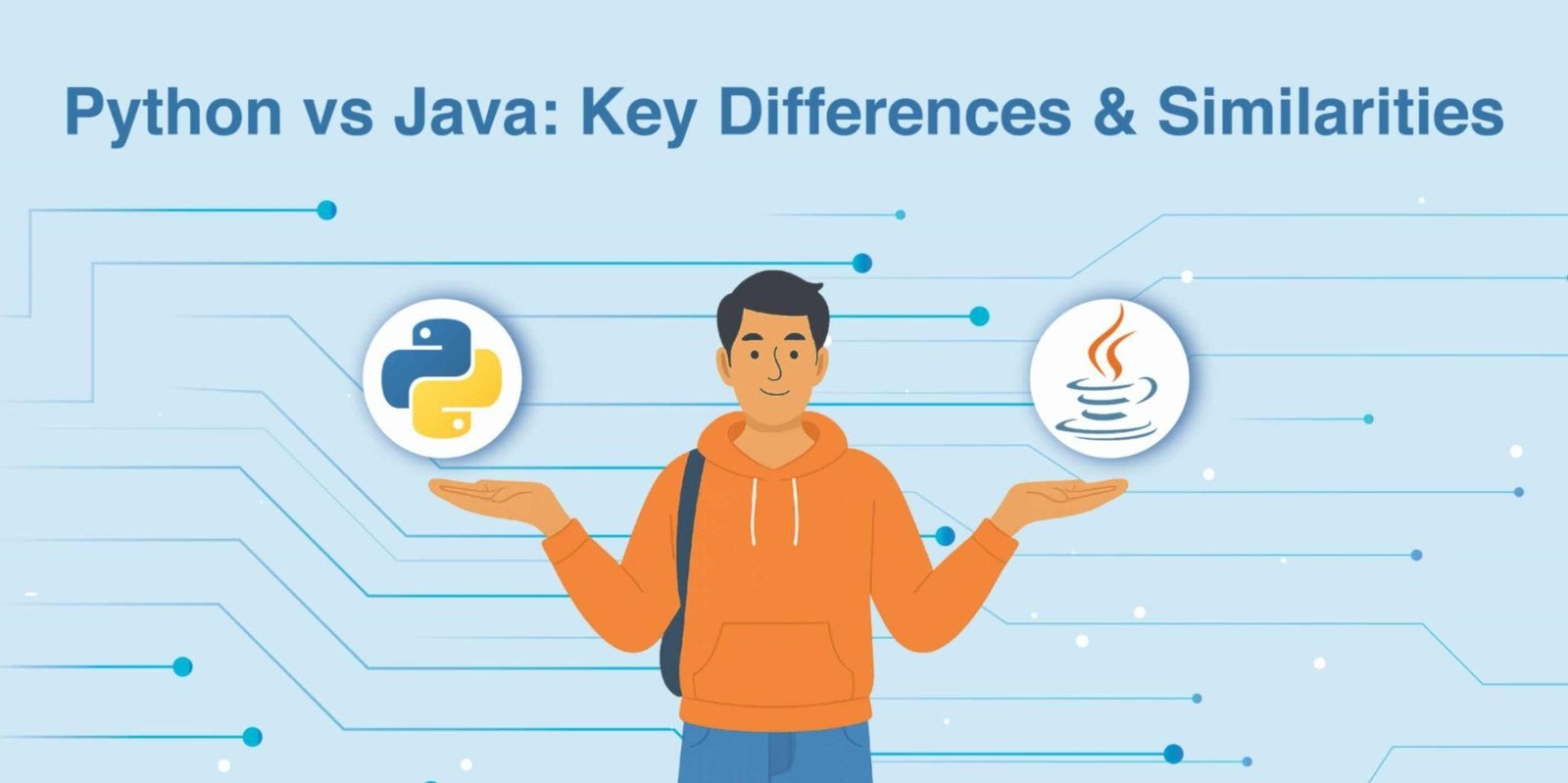Python vs. Java: Key Differences & Similarities

Choosing the right programming language is essential in data science and software development. While Python and Java are versatile and widely used, their design philosophies and use cases vary significantly. Understanding these differences helps guide learning paths, shape career decisions, and increase employability for students, working professionals, and aspiring data scientists. This blog explores the core contrasts and commonalities between Python and Java, especially in the context of data science.
Understand the Key Differences Between Python and Java
Python is an interpreted, dynamically typed language known for simplicity and rapid prototyping. Java is a statically typed, compiled language valued for performance and scalability.
Key Differences between Python and Java:
Typing System
Java is statically typed, while Python is dynamically typed.
Compilation
Python is interpreted during compilation, while Java is compiled into bytecode before being interpreted by the JVM.
Syntax
Python is concise and minimalistic. Java is verbose and structured.
Speed
Java generally performs faster due to compiled code.
Ease of Learning
Python is easier for beginners.
Explore How Python and Java are Used Across Real-World Industries
Python is widely used in web development, automation, artificial intelligence, and data research. It is a preferred language for machine learning because of libraries like TensorFlow, Pandas, and NumPy.
Large-scale systems, Android apps, and enterprise software are all powered by Java. It is extensively utilized in backend online services, finance, and telecommunications.
Example:Python: Building machine learning models with scikit-learn.
Java: Building scalable web servers with Spring Boot.
Find Out Which Language is Easier for Beginners to Learn
Python is perfect for novices because of its straightforward syntax, low setup requirements, and interpreted nature. Java's complicated syntax and boilerplate code make it more challenging to learn.
Example: Print statement comparison:
# Python
print("Hello, World!")
// Java
public class Main {
public static void main(String[] args) {
System.out.println("Hello, World!");
}
}
Python's simple, user-friendly syntax, which emulates normal English, makes it a popular choice for novices. It frees novices from the burden of intricate syntax rules so they may concentrate on learning programming fundamentals. Because of its complex syntax and early emphasis on object-oriented programming, Java has a longer learning curve despite its strength. Python typically provides a more seamless entry point for novices in data science.
Compare the Syntax and Readability of Python and Java
Python places a strong emphasis on readability and frequently uses fewer lines of code. Because Java imposes structure, huge systems become more verbose but are easier to maintain.
Example: Sum of a List
# Python
numbers = [1, 2, 3]
total = sum(numbers)
// Java
int[] numbers = {1, 2, 3};
int total = 0;
for (int num : numbers) {
total += num;
}
Learn How Dynamic and Static Typing Affect Your Coding Experience
Variables do not need explicit type declarations.
Easier to write, but may lead to runtime errors.
Type checking at compile-time.
Safer and easier to debug, especially for large applications.
# Python
a = 5 # Integer
a = "Now a string"
// Java
int a = 5;
a = "Now a string"; // Compile-time error
Python vs. Java in Performance and Execution Speed
Java generally outperforms Python in execution speed due to its compiled nature. Python trades speed for developer productivity and flexibility.
Java: Good for high-performance applications like trading systems.
Python: Suitable for rapid development and prototyping.
Understand How Both Languages Support Object-Oriented Programming
Both Python and Java support object-oriented programming (OOP) principles like encapsulation, inheritance, and polymorphism.
Example – Class and Object:
# Python
class Person:
def __init__(self, name):
self.name = name
p = Person("Alice")
// Java
public class Person {
String name;
Person(String name) {
this.name = name;
}
}
Person p = new Person("Alice");
Explore Unique Features that Make Python and Java Stand Out
List comprehensions
First-class functions
Dynamic typing
Extensive scientific libraries
Strong memory management
Multithreading support
Platform independence via JVM
Robust type system
Get to Know the Libraries and Ecosystems that Support Data Science.
NumPy, Pandas, Matplotlib, scikit-learn, TensorFlow, Keras
Weka, Deeplearning4j, MOA, Java-ML
Python’s ecosystem is more mature for data science, offering robust tools for end-to-end workflows.
Discover the Development Tools and IDEs That Help You Code Better
Jupyter Notebook (for data science)
PyCharm
VS Code
IntelliJ IDEA
Eclipse
NetBeans
While Jupyter is great for experimentation, Java IDEs excel in building and managing large codebases.
Brief Summary on Python vs Java
| Feature | Python | Java |
|---|---|---|
| Typing | Dynamic | Static |
| Syntax | Simple and Reachable | Verbose and Structured |
| Speed | Slower | Faster |
| Data Science Use | Extensive Libraries | Limited but growing |
| Beginner Friendly | Yes | Moderate |
| Ecosystem | Rich in ML and Data Tools | Rich in Enterprise Tools |
Why Learn Data Science with Bhrighu?
Bhrighu Academy offers a structured and flexible approach to learning data science:
NASSCOM-Certified Courses
Aligned with national skill standards.
Hands-on Learning
A project-based curriculum ensures real-world experience.
Placement Assistance
Support for job roles, internships, and advanced education.
Japan Pathway Programs
Learn and work in Japan through curated programs.
Micro-Certification Tracks
Stay ahead with industry-relevant short courses.
Whether you choose Python or Java, Bhrighu’s data science certification course helps you build foundational and advanced skills.
Conclusion: Which Language Should You Start With?
If you want to enter the field of data science, Python is generally the recommended starting point due to its simplicity, vast libraries, and widespread use in analytics and machine learning. However, if you're leaning towards mobile development, large-scale enterprise software, or high-performance applications, Java may be the better fit.
No matter which language you choose, mastering the concepts and applying them in projects is what truly matters. At Bhrighu Academy , you’ll find the right curriculum, mentorship, and career support to guide your journey. Enroll now and take the first step toward a future-ready data science career.
Frequently Asked Questions
Which language is better for beginners in data science?
Python is generally better suited for beginners in data science. Its clean syntax, dynamic typing, and minimal setup make it easier to learn and use for tasks like data analysis, visualization, and machine learning. Unlike Java, Python doesn't require complex boilerplate code, allowing learners to focus on understanding data science concepts rather than language mechanics.
How much faster is Java compared to Python for data processing?
Java is typically faster than Python for data processing due to its compiled nature and static typing, which offer better performance and memory management. While exact speed differences depend on the specific task, Java is preferred for high-performance systems such as trading platforms. Python, however, prioritizes development speed and flexibility, making it ideal for rapid prototyping and exploratory data analysis despite being slower in execution.
Can I switch between Python and Java easily once I've learned one?
Yes, switching between Python and Java is quite manageable, especially if you understand programming fundamentals. Both languages support object-oriented principles and share similar control structures. However, adapting to differences in syntax, typing systems, and development tools may require practice. For instance, Python’s dynamic typing and minimal syntax differ greatly from Java’s statically typed, verbose structure. But once you're comfortable with one, the transition becomes easier with consistent coding practice.
Which language has better machine learning libraries?
Python leads in machine learning libraries. It offers a mature ecosystem with tools like TensorFlow, scikit-learn, Keras, and PyTorch, which are widely used in academia and industry. These libraries simplify model development, training, and deployment. While Java has some ML support through libraries like Weka and Deeplearning4j, it lacks the extensive community and versatility of Python’s data science toolkit, making Python the preferred choice for most ML tasks.
Are Python skills more in demand than Java for data science roles?
Yes, Python skills are currently in demand in data science roles. Python’s dominance in analytics, machine learning, artificial intelligence, and automation makes it the preferred language for data science job profiles. Its extensive libraries, integration with data platforms, and ease of use contribute to its popularity. While Java is still valued in software development and enterprise applications, Python leads when hiring for data-focused roles.





